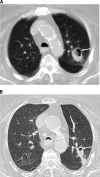Purpureocillium lilacinum as a cause of cavitary pulmonary disease: a new clinical presentation and observations on atypical morphologic characteristics of the isolate
- PMID: 22322350
- PMCID: PMC3347118
- DOI: 10.1128/JCM.00150-12
Purpureocillium lilacinum as a cause of cavitary pulmonary disease: a new clinical presentation and observations on atypical morphologic characteristics of the isolate
Abstract
The first case of cavitary pulmonary disease caused by Purpureocillium lilacinum is described. The isolate showed atypical microscopic characteristics similar to Acremonium and Fusarium spp., which necessitated molecular identification by sequencing of multiple conserved loci. The patient responded to voriconazole, reinforcing its therapeutic efficacy for P. lilacinum infections.
Figures



References
-
- Ahmad S, Khan ZU, Theyyathel AM. 2007. Diagnostic value of DNA, (1–3)-beta-D-glucan, and galactomannan detection in serum and bronchoalveolar lavage of mice experimentally infected with Aspergillus terreus. Diagn. Microbiol. Infect. Dis. 59:165–171 - PubMed
-
- Al-Sweih N, Ahmad S, Khan ZU, Khan S, Chandy R. 2005. Prevalence of Candida dubliniensis among germ tube-positive Candida isolates in a maternity hospital in Kuwait. Mycoses 48:347–351 - PubMed
-
- Antas PR, Brito MM, Peixoto E, Ponte CG, Borba CM. 2012. Neglected and emerging fungal infections: review of hyalohyphomycosis by Paecilomyces lilacinus focusing in disease burden, in vitro antifungal susceptibility and management. Microbes Infect. 14:1–8 - PubMed
Publication types
MeSH terms
Substances
Associated data
- Actions
- Actions
- Actions
- Actions
LinkOut - more resources
Full Text Sources
Medical
Molecular Biology Databases
Miscellaneous

